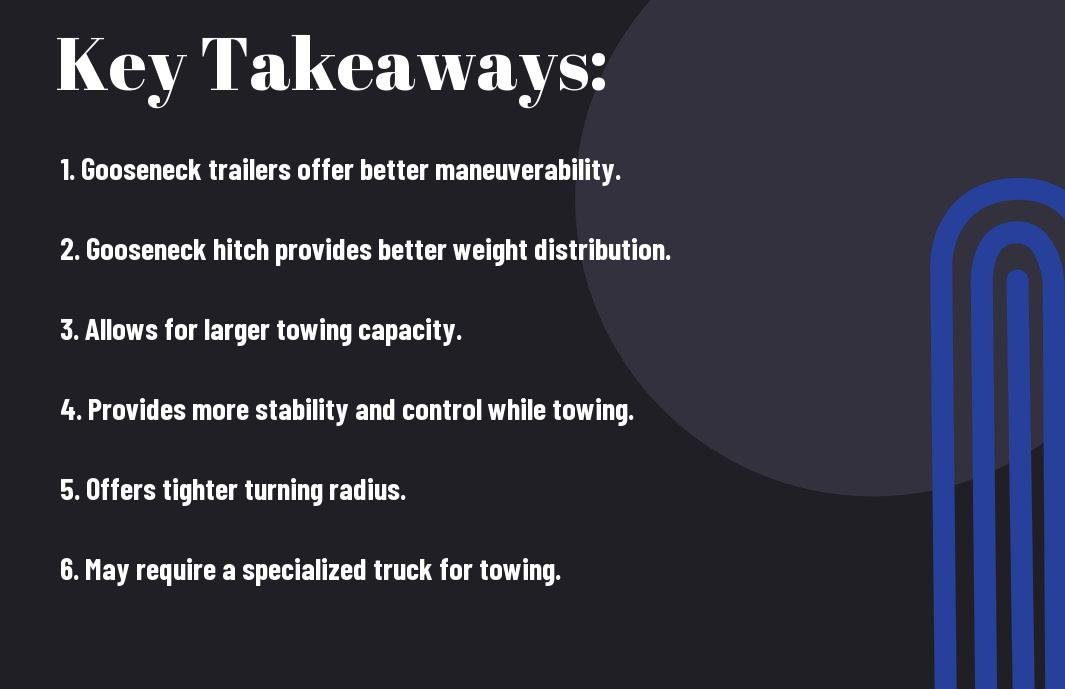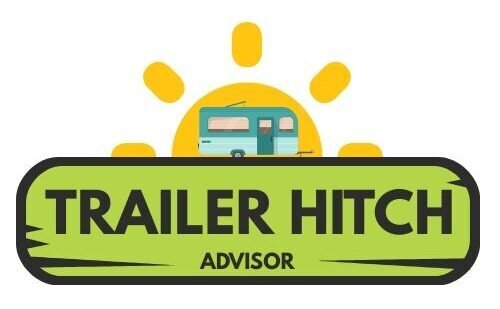Have you ever wondered if you could haul more weight with a gooseneck trailer? When it comes to towing heavy loads, a gooseneck hitch offers several advantages over conventional bumper pull trailers. By distributing the weight over the truck’s rear axle, a gooseneck hitch provides increased stability and control while towing, allowing you to pull heavier loads without compromising safety. Additionally, the design of a gooseneck trailer allows for a tighter turning radius compared to bumper pull trailers, making it easier to maneuver in tight spaces. However, it is important to note that proper weight distribution and adherence to towing capacity limits are crucial for safe towing with a gooseneck hitch. Be sure to carefully consider the weight of your load and your truck’s towing capacity before hitching up.
Key Takeaways:
- Improved maneuverability: Gooseneck trailers offer better maneuverability compared to traditional trailers, making it easier to navigate tight spaces and corners.
- Increased stability: The gooseneck hitch extends over the rear axle of the towing vehicle, providing improved stability and control while towing heavy loads.
- Higher towing capacity: Gooseneck trailers have a higher towing capacity compared to bumper hitch trailers, allowing you to pull more weight with ease.
- Enhanced weight distribution: The weight of the gooseneck trailer is distributed more evenly over the towing vehicle and trailer, reducing the likelihood of swaying and improving overall handling.
- Better turning radius: Gooseneck trailers allow for a tighter turning radius, giving you greater flexibility when navigating sharp turns and obstacles.
- Overall safety: The design and functionality of gooseneck trailers contribute to a safer towing experience, reducing the risk of accidents and mishaps on the road.
- Cost-effectiveness: While gooseneck trailers may require a specialized hitch, their benefits in terms of towing capacity, stability, and maneuverability can result in long-term cost savings and efficiency.

Understanding Gooseneck Hitches
Obviously, the key to pulling more with a gooseneck lies in understanding the unique advantages and features of this type of hitch. By grasping the intricacies of gooseneck hitches, you can make an informed decision on whether this setup is the best choice for your towing needs.
Definition and Design Features
Gooseneck hitches are characterized by their heavy-duty design and their placement in the bed of the towing vehicle. The hitch consists of a ball mounted in the bed of the truck, which connects to a hitch on the trailer. This design feature allows for increased stability and a greater weight capacity compared to standard hitches.
Comparison to Standard Hitches
When it comes to comparing gooseneck hitches to standard hitches, there are several key differences that set them apart. The table below highlights the most important distinctions between the two types of hitches:
Gooseneck HitchesStandard Hitches
Greater stability and weight capacity Lower stability and weight capacity
Located in the bed of the towing vehicle Located under the rear bumper of the towing vehicle
By understanding the differences between gooseneck and standard hitches, you can determine which option is best suited for your towing needs.
Remember that your ultimate goal is to safely and effectively transport your cargo from one point to another, so the choice of hitch is of utmost importance.
Mechanics of Gooseneck Towing
Now, let’s dive into the mechanics of gooseneck towing and how it differs from other types of towing. Understanding the intricacies of gooseneck towing will help you make informed decisions when it comes to hauling heavier loads.
Weight Distribution and Stability
When it comes to gooseneck towing, one of the key considerations is weight distribution and stability. The design of a gooseneck hitch allows for the weight of the trailer to be distributed more evenly between the front and rear axles of your tow vehicle. This results in increased stability and control, especially when towing heavy loads. The positioning of the gooseneck hitch also helps to minimize sway and improve overall handling. With proper weight distribution, you can ensure a smoother and safer towing experience.
Towing Capacity Considerations
When it comes to towing capacity, gooseneck setups offer several advantages. With a gooseneck hitch, you can typically tow heavier loads compared to a conventional bumper pull hitch. The design of the gooseneck hitch provides a more secure and stable connection between the tow vehicle and the trailer, allowing you to take full advantage of your vehicle’s towing capacity. However, it’s important to always adhere to your vehicle manufacturer’s towing capacity to ensure safe and legal towing practices.
Practical Applications
To answer the question of whether you can pull more with a gooseneck, it’s important to consider the practical applications of using a gooseneck trailer hitch. Understanding how and where a gooseneck can be utilized will help you make an informed decision on whether it is the right choice for your towing needs.
Uses in Agriculture and Industry
When it comes to agriculture and industry, the gooseneck trailer hitch is a popular choice for towing heavy loads. Its design allows for a greater weight capacity and stability, making it ideal for transporting large equipment, livestock trailers, and heavy machinery. The ability to distribute the weight of the load over the rear axle of the towing vehicle makes it a valuable tool in these sectors. Whether you are hauling bales of hay, a large piece of farming equipment, or industrial machinery, the gooseneck can handle the job with efficiency and stability.
Recreational Uses and Limitations
For recreational purposes, the gooseneck trailer hitch can also be a valuable asset. It is commonly used for towing large RVs, horse trailers, and even car haulers. The stability and weight distribution provided by the gooseneck design make it a safer option for towing heavy recreational vehicles. However, it’s important to note that the size and maneuverability of the gooseneck can also present limitations in certain recreational settings, such as tight campgrounds or maneuvering through urban areas. Understanding these limitations will help you make an informed decision on whether a gooseneck is the right choice for your recreational towing needs.
Safety and Legal Aspects
Keep in mind that safety is paramount when pulling a gooseneck trailer. Your vehicle, hitch, and trailer must all be in proper working condition to ensure a safe and smooth towing experience. Additionally, understanding the legal aspects of towing with a gooseneck is crucial to avoid any potential legal issues on the road.
Safety Precautions and Best Practices
When towing with a gooseneck, it’s important to follow certain safety precautions and best practices. Ensure that your vehicle and trailer are properly matched in terms of weight and towing capacity. Always perform a thorough inspection of your equipment before hitting the road, including checking tire pressure, trailer brakes, and the hitch connection. Secure all cargo properly inside the trailer to prevent shifting during transit, which can affect the stability of your vehicle. Lastly, always double-check that all lights and signals on the trailer are working to ensure optimal visibility on the road.
Legal Weight and Size Limits
Understanding the legal weight and size limits for gooseneck trailers is essential to avoid any legal repercussions during transport. Each state has its own regulations regarding maximum trailer length, width, and weight, so it’s crucial to familiarize yourself with the laws in the states you’ll be traveling through. Exceeding these limits can result in expensive fines and potential safety hazards on the road. By adhering to legal weight and size limits, you can ensure a safe and compliant towing experience.
Can you pull more with a gooseneck?
Presently, you now understand the benefits of using a gooseneck trailer hitch for towing heavy loads. Not only does it provide increased stability and a smoother ride, but it also allows for greater towing capacity. With a gooseneck hitch, you can pull more weight than with a conventional bumper hitch, making it the preferred choice for those needing to transport heavy equipment or livestock. Remember to always adhere to the recommended weight limits and follow proper safety guidelines when using a gooseneck hitch for towing.
FAQ about Pulling More with a Gooseneck
Q: What is a gooseneck trailer?
A: A gooseneck trailer is a type of trailer that is attached to the towing vehicle using a hitch that is mounted in the bed of the truck, rather than at the rear bumper. This design allows for a more stable and secure connection, making it suitable for towing heavier loads.
Q: Can you pull more weight with a gooseneck?
A: Yes, gooseneck trailers are designed to allow for the towing of heavier loads compared to conventional bumper-pull trailers. The gooseneck hitch is situated closer to the vehicle’s rear axle, which improves the trailer’s stability and handling, enabling it to handle heavier weight capacities.
Q: What types of vehicles are suitable for towing with a gooseneck hitch?
A: Typically, heavy-duty trucks such as full-size pickups and commercial trucks are suitable for towing with a gooseneck hitch. These vehicles are equipped with the necessary power and stability to handle the increased weight and load of a gooseneck trailer.
Q: Are there any special considerations when towing with a gooseneck?
A: Yes, when towing with a gooseneck, it’s essential to ensure that the towing vehicle is properly equipped with the appropriate gooseneck hitch, as well as an integrated trailer brake controller. Additionally, it’s crucial to adhere to the recommended weight limits and ensure that the trailer is loaded and balanced correctly to maintain safe towing conditions.
Q: What are the advantages of using a gooseneck for towing?
A: The main advantages of using a gooseneck for towing include increased stability and control, especially when towing heavier loads. The design of the gooseneck hitch also allows for a tighter turning radius, making it more maneuverable in tight spaces. Overall, the gooseneck provides a safer and more efficient towing experience for heavier loads.
